RECOIL OFFGRID Preparation Carleigh Fairchild Discusses Her Time on the TV Show Alone
There’s something primal that stirs within us at the thought of being isolated in a remote place. As social creatures, many of us instinctively shy away from situations that separate us from our fellow humans. Others are drawn to solitude, so that they may more clearly hear their inner voice — a voice that’s often drowned out by the modern-day electronic hum that permeates our lives. The latter individuals typically remain secluded only for a short period of time, before having to return to the social tasks their lives demand. However, there are an elite few who have grappled with not only the physical dangers of the remote wilderness, but also with their own inner demons for months at a time without another human soul to lean on for support. Carleigh Fairchild is one such person.
Since the age of 13, her life has been immersed in wilderness survival and survival skills training. After turning 18, she moved to Washington state to learn primitive skills, and tested herself by successfully solo backpacking 500 miles on the Pacific Crest Trail. Having traveled the country honing her skills, she took on one of popular culture’s most difficult survival challenges by becoming a contestant on History Channel’s Alone — not once, but twice.
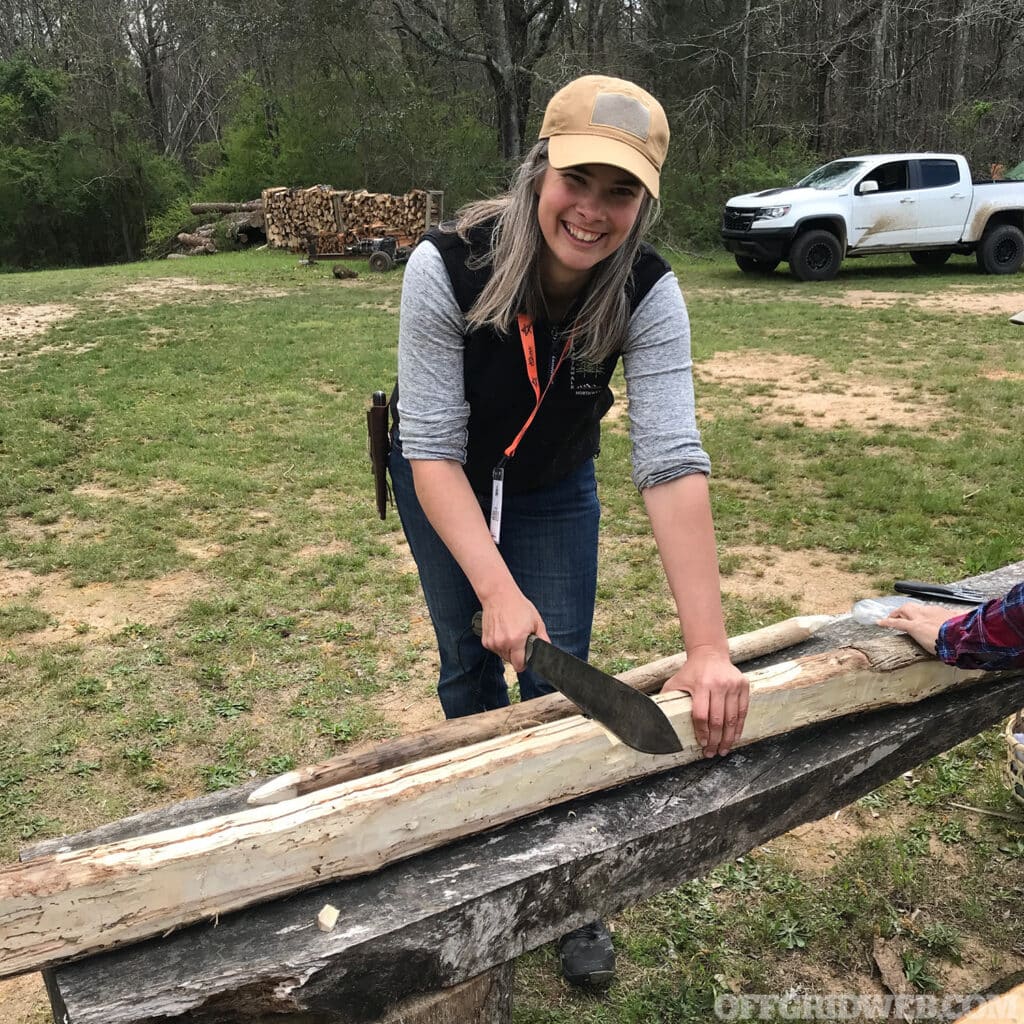
First, she went to the foothills of the Andes mountains in Patagonia, Argentina, on Season 3. She returned to the show on Season 5, which took place in Mongolia. Today, Carleigh uses her vast experience by teaching others how to reconnect with their surroundings and themselves, much like our not-so-distant ancestors did on a daily basis. We were able to attend a wild edibles class she was teaching at the Georgia Bushcraft Campground near Watkinsville, Georgia, and had the opportunity to sit down with her to learn more about her survival experience and what it was like to survive for 86 days in Patagonia, alone.
RECOIL OFFGRID: You started learning wilderness survival skills as a child, what do you feel drew you to that endeavor?
Carleigh Fairchild: My mom started me on the path of learning survival skills when she went to the Tracker School run by Tom Brown Jr. in New Jersey. They have a wide variety of classes. They start with their Standard Course which covers pretty much all of the basics of survival skills, and then there’s more advanced survival skills and tracking classes.
She came home from that and showed me the bow drill kit she had made. It was my first look at making a fire without matches or a lighter. I was fascinated that you could truly rub two sticks together and make a coal. I wanted to learn more. Luckily, I was able to attend a teen summer camp the next year when I was 13 to learn earth skills. I loved the connection the skills brought to me — connection with the earth, connection with my own abilities, and connection with others also passionate about those skills.
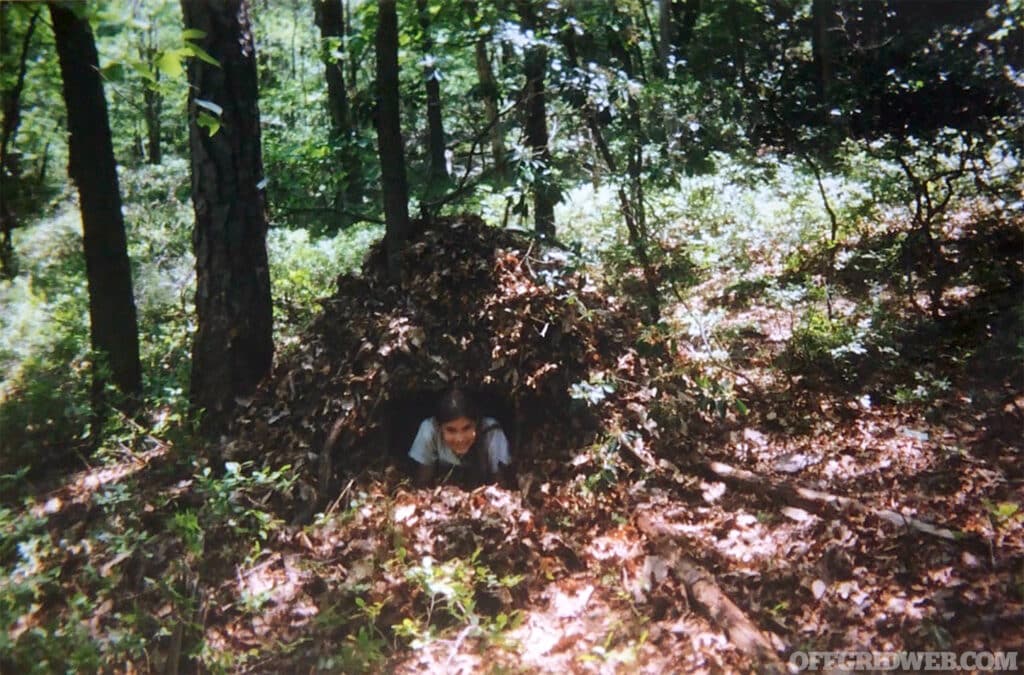
Above: As a young teenager, Carleigh spent time in the woods building shelters and practicing wilderness skills.
ROG: Earth skills is a term you don’t hear too often. What do you mean by that?
CF: Earth skills are basically anything that involves working with the earth. Things like drill fires, finding water, building shelters. Sometimes I still use the term survival skills, but I am trying to intentionally use “earth skills” more often, because they are skills that can be used in daily life, not only when trying to survive.
All too often the survival mindset is one of scarcity and constant challenge. I want to live a life of abundance and ease, at least some of the time. So why am I just surviving when I want to live and thrive? That was my focus when I was on Alone — I am not here surviving, I am here to live.
ROG: What were some of the most challenging skills you developed, and why were they so difficult?
CF: Flint knapping and trapping. It has been harder for me to connect with those skills and see and know how they work. I think this was because I was less drawn to them, partly because of interest and partly because I sometimes have a difficult time understanding things like the structure of rocks or trapping dynamics. I can make a stone tool, but I don’t really knap pieces into blades or arrow heads. At the moment, I have a serviceable level of skill in these areas, but I don’t really spend a lot of time on them. I feel everybody is drawn to certain things in life, and for me, I’m drawn to other skills.
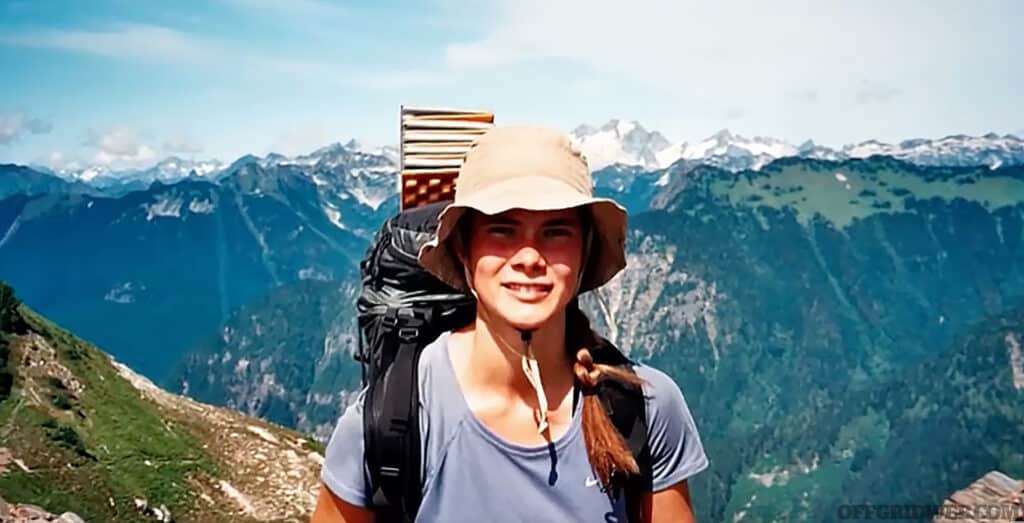
Above: Solo hiking a 500-mile section of the Pacific Crest Trail.
ROG: How was survival different in Patagonia versus Alaska or the continental United States?
CF: There were so many species of plants, trees, birds, and animals I was unfamiliar with in Patagonia, but that made it exciting to learn about. Before I arrived there, I had a short amount of time — maybe two to three weeks — where I tried to research as much as I could about the region. But the region was so huge, it was challenging to learn everything about it. Even the moon looked different because I was in the southern hemisphere and most of the constellations were different. It’s a little like the eastern United States, where you have everything from swamps in Florida to the hardwood forests in Maine, and everything in between. There are a lot of distinct species, so it was a bit of a shot in the dark researching before I went.
Once we were on the ground there, we had a little bit of time to learn. We were staying on a style of ranch, and there really wasn’t anyone to help us get acquainted with the area. We had a brief orientation, but once we were out there competing, there wasn’t anyone we could ask questions to. I think I learned maybe three new plants that were helpful that I found in my area. All the other ones that I harvested for food were ones that I knew from the United States.
The forest in Patagonia was primarily evergreen broadleaf trees, but the leaves were very tiny. When it came to shelter building, I was challenged by the leaves being so small. I couldn’t gather great big armloads, only small handfuls. So I had to make a bag out of the cowhide I found to gather them.
ROG: One of the most difficult challenges for Alone contestants are the feelings that accompany isolation. What was the most effective method of coping with loneliness that you used to outlast your competitors?
CF: My coping strategy began when I first landed on the pebble beach where I started. Even though there was a pressing need to get a shelter made, get a fire going, and explore the area, the first thing I did was actually sit down and take a few deep breaths and observe where I was before just rushing off. During this process, I introduced myself to the land, and said out loud what my intentions were for being there. Something along the lines of, “Hey, I’m Carleigh. I’m here to build a home and live here for as long as I can as a caretaker of the land, and hopefully be here long enough to win.” In this way, even though I was alone the whole time I was not lonely very often.
I built personal connections with the nature around me — the birds, plants, trees, mountains, and the lake. Connecting with nature was my most effective method of coping with loneliness. Being emotionally honest and recognizing when I felt that isolation turning into loneliness was helpful as well. When I found myself thinking about my loved ones, I acknowledged my feelings, then did my best to redirect back to the present moment and what I needed to do.
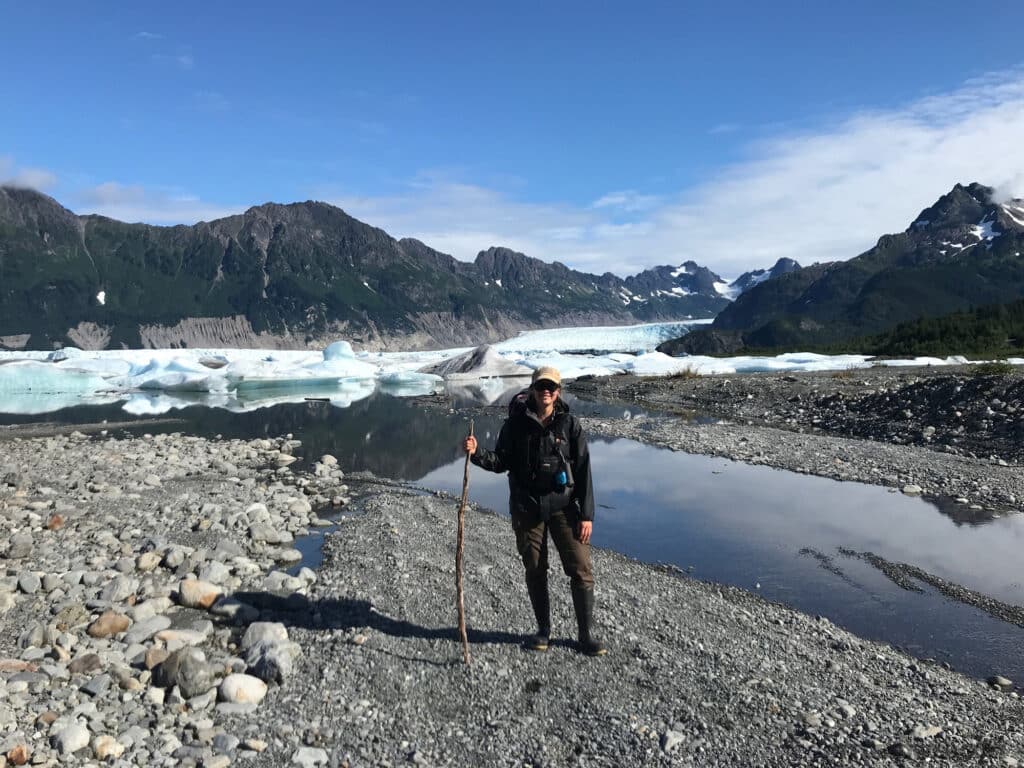
Above: Hiking and enjoying the natural beauty of Alaska.
As my time in the Patagonia wilderness progressed, I continued building connections with the land by exploring the land daily and creating a mental map of where everything was. Certain areas would stand out in my mind — like certain trees, game trails, berry patches, places for firewood — and I would place them on my mental map as if I was looking down on it from above. Taking my role as a caretaker of the land seriously, if I had to harvest a sapling for my shelter, or food, or firewood, I did so in a way that the ones left behind would hopefully grow stronger and healthier. This deepened my connection with the land and was a respectful and reciprocating relationship.
ROG: Out of all the survival skills you’ve learned over the course of your life, what are your top three you would recommend everyone should learn?
CF: I would split skills into two categories, soft skills and hard skills, so I’ll give you three of each. For soft skills, the three most important I think would be the power of observation, being able to improvise/adapt, and trusting yourself. The three most important hard skills I think would be natural shelter making, fire making, and basket making. I know the talk of which skills are the most important can be a contentious subject, but contention can be helpful sometimes.
Now when I say the power of observation, that encompasses a lot, and is not just what you see with your eyes. It’s more of a developed awareness. What we are (or aren’t) aware of limits us and what we believe is possible. So, it’s about being able to observe what’s going on around us externally, what’s happening with our bodies internally, and how those processes drive us in a circumstantial and contextual way. It’s really a full spectrum sense of physical awareness coupled with mindfulness, intuition, and even spirituality.
Your power of observation ties in directly to improvisation and adaptation, because when your awareness is developed, you can start asking yourself questions like, “what do I need?” or “what do I have that can make something I need?” Then you can start looking for a potential resource to address that concern. If we don’t know what we need, then how do we even begin to look for a solution? If we can identify what is around us and know what resources are available, then we can begin the process of adapting and improvising.
Trusting ourselves is not very predominant in our society these days, but it is a vital skill. There are so many things in marketing or advertising that are saying things like, you’re not good enough, or you need this item to feel good. I think we are actually born with the ability to know a lot of things, and because of how many people grow up, we don’t keep that trust in ourselves. It gets overshadowed by the external things that get projected on us. I think it’s something that we all need to work on more and rediscover about ourselves.
Shelter making is a skill that is super critical in every environment, because we are humans, and we need protection from extreme heat, cold, precipitation, etc. So, if you don’t have a building to shelter in, knowing how to build your own is critical. Plus, I think it’s just a fun skill to learn.
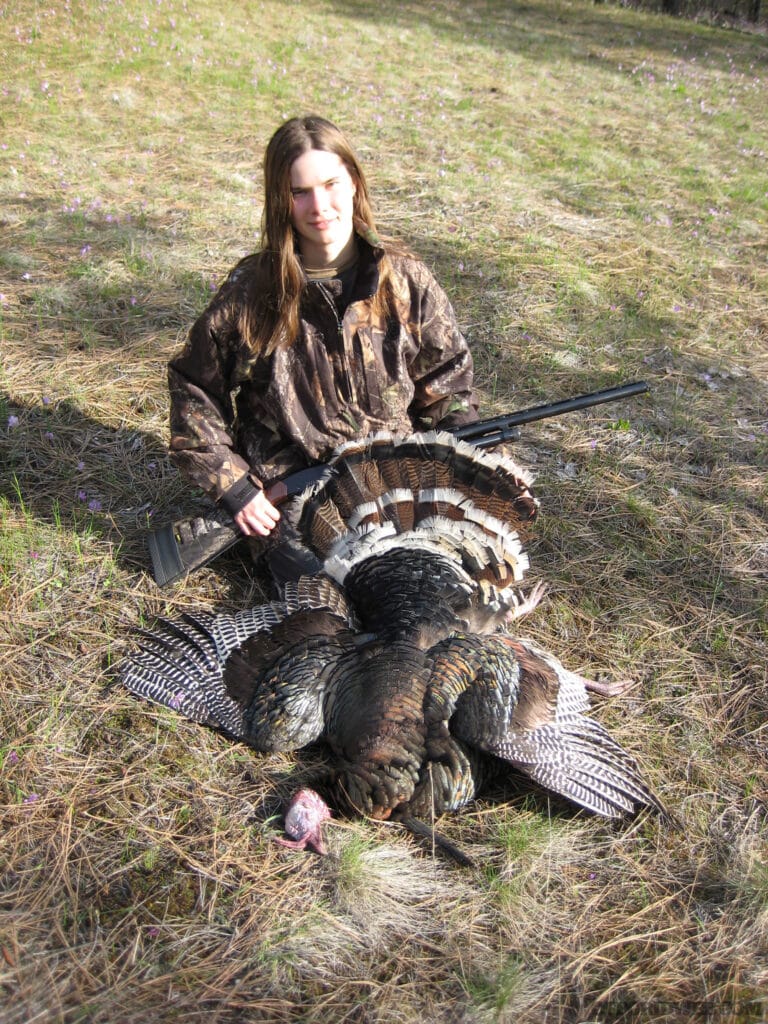
Above: After a successful turkey hunt.
Fire-making is crucial because it will cook food, purify water, keep you dry, and can be a weapon if you’re concerned about some crazy animals or people. It can even be a comfort item. Learning how to make a fire is another fun skill that is easy to practice in your backyard or with friends. You can also challenge yourself by seeing if you can gather enough items to start a fire in five minutes or less.
Basket-making makes it to my top three hard skills because for any long-term survival situation or even weekend survival camping, we need containers to hold things. We need containers to hold the food that we forage, storage of fire-making supplies, and if a container is sealed properly, transport larger volumes of water. It’s a very utilitarian item that makes life so much easier.
There are so many other skills that are wrapped up into those three, like knife or ax skills and plant identification. If you know how to build a shelter, start a fire, or make a basket, you’ll have several other vital skills already in your toolbox.
ROG: How did the locals in South America and Mongolia react to your goals as an Alone contestant?
CF: We had very limited time in South America to interact with locals — almost none. They brought us to a local farm for a mini cultural experience in Patagonia, but there wasn’t a lot of one-on-one conversation going on. Mongolia was more or less the same. During the limited interaction I had with locals, they seemed to be excited for us but also very curious as to why we were trying to survive there. They wished us well.
ROG: How did your experience in Patagonia affect the items you decided to pack and bring with you to Mongolia?
CF: My experience in Patagonia affected my choice of items to pack when I went to Mongolia, because I had a better understanding of just how important it was to be able to get food. So, I wanted to increase my tools that would help me obtain more food resources. In Mongolia, instead of an ax, I brought a bow and arrows in hopes that I would be able to harvest a larger animal.
One of my biggest shifts in mindset going between the two locations was that I needed to spend more time focusing on nutrition. Several times in the first three weeks at Patagonia, finding food was almost an afterthought, and I focused primarily on making my shelter. I thought I could just fast or eat a tiny bit and be fine. It didn’t take long to realize that making that choice over and over again isn’t helpful. So, starting on day one in Mongolia, I made a conscious effort to spend several hours a day finding food, whether that was hunting, foraging, or fishing.
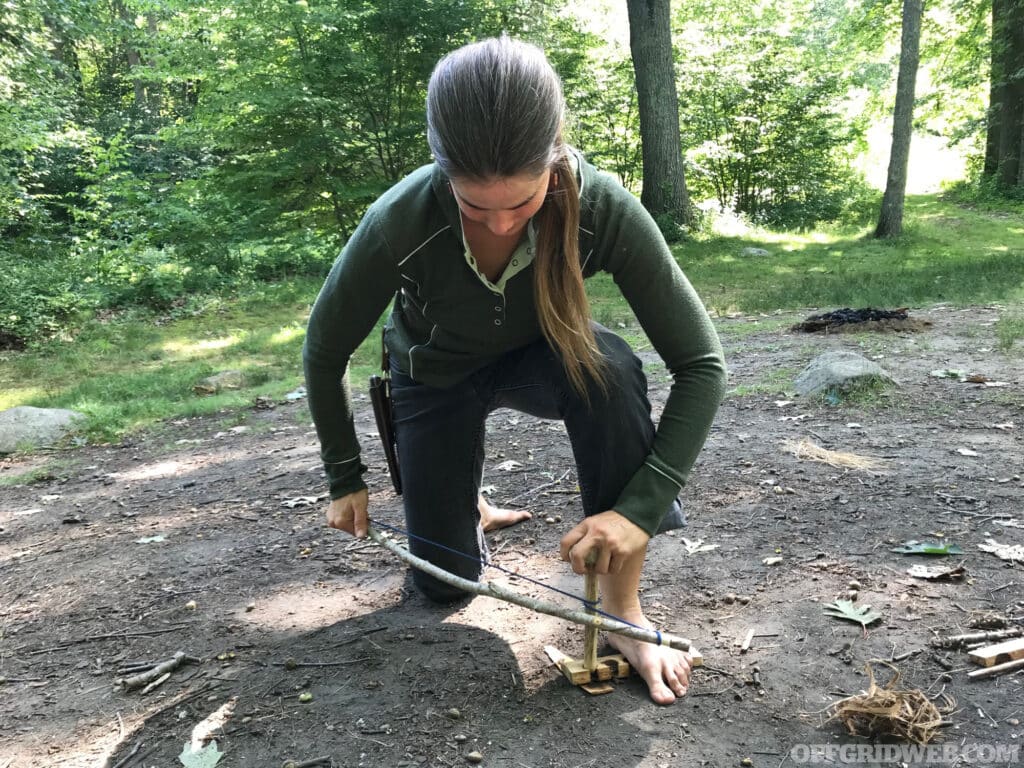
Above: Starting a fire with the bow drill method.
ROG: You’re teaching your own course now, Human Nature Connection: Survival Secrets That Can Save & Grow Your Life, Bond Your Family & Unite Your Team. How is your course unique compared to other survival courses?
CF: I got the idea for Human Nature Connection from my time surviving out in the wild of Patagonia for 86 days. While completely alone, I realized how critical survival skills are not just for the show I was a participant on, but in our daily lives. The skills go much deeper than making and finding shelter, water, fire, and food. I learned to truly connect with nature and myself out there, and it helped me come back and be much stronger in my relationship with myself, my significant other, and with teams at work. I believe more people could use these skills to enhance their lives and relationships at home and work.
This is not just a course, but a system designed to help executives, business owners, and entrepreneurs gain survival skills necessary in these uncertain times, while also allowing them to reconnect back to themselves, bond more with their family, and unite their teams.
The incidence rate of natural disasters, manmade disasters, recreational mishaps, and effects from the silent epidemic of disconnection are growing daily. To survive and thrive in this new world, you need to develop survival skills to deal with shifts in nature, situations, and your moment-to-moment reality by having the basic survival skills of shelter, water, fire, food, so you can save your life or those you love. These skills are also the hidden tools for deepening internal and relational connections that help us be resilient in the face of the silent epidemic of disconnection.
What makes Human Nature Connection unique is how the 4 Pillars of Survival Living and the 4 Elements of Survival Living become a bridge to overcome the challenges that modern life throws at us every day. And you don’t have to experience it alone. I offer the course as a hybrid with online content, coaching calls, and an in-person immersion experience. You can take it with your significant other, family, or team.
It’s powerful to see how revitalized people are after taking the course. People who were dealing with a lot of anxiety and fear in their life when they started the course are not held back any longer by the fears and anxiety after completing the program. Entrepreneurs have started new businesses to help their communities in an impactful way. It’s really profound to see what people can become when they work on developing these internal and relational survival living skills. You can read more about the course at humannatureconnection.com.
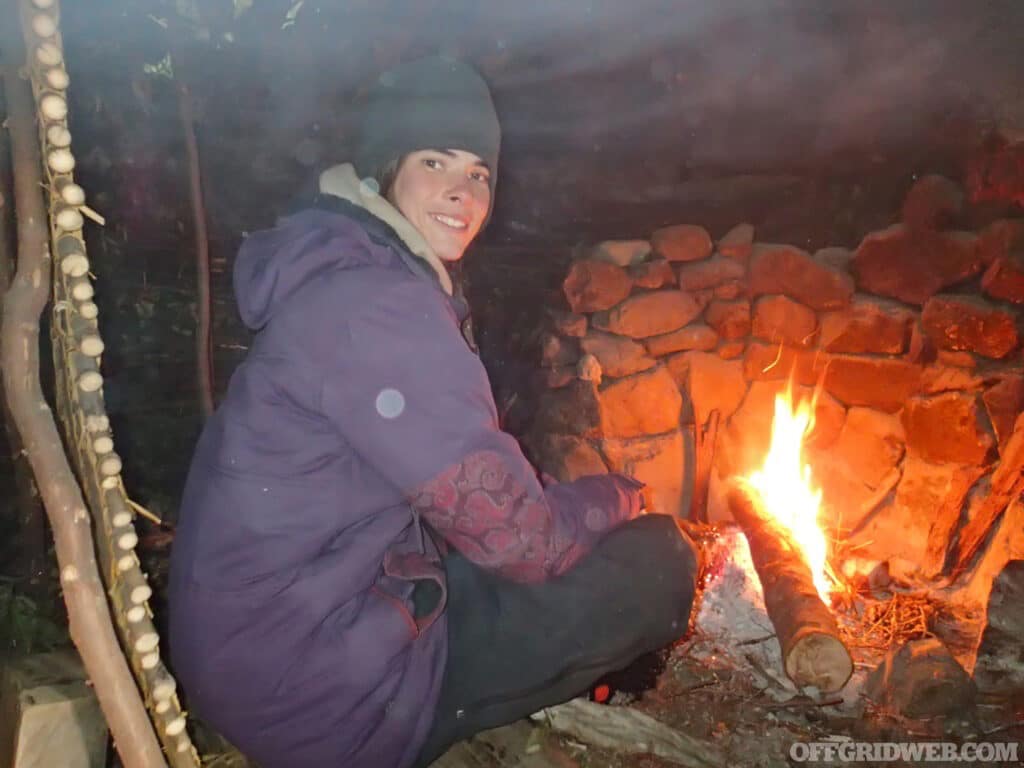
Above: Carleigh lived off the land in Patagonia and filmed herself for 86 days on History Channel’s Alone Season 3.
ROG: When you’re at a speaking engagement, what are some of the most common questions your audience seems interested in, and what are your answers?
CF: “How was the transition home?”
I was full of gratitude for the people in my life and getting to be with them again in person. I loved eating fresh food out of my garden and eggs from my chickens and ducks.
“Was there anything difficult about going home?”
Eating again was amazing. And it was also challenging. I found that I got full very quickly but wanted to keep eating. Because my stomach and abdominal muscles had shrunk, it was painful to be overfull. I also had some body image issues as I returned to my regular weight, by the time my mind would get used to the way I looked, I would have gotten heavier again.
“What was the hardest part about being out there?”
Two things. One was actually while fishing. The cycle of hope and disappointment that happened every time I cast out and didn’t catch a fish. Second, so many things being unknown was hard, especially as time went on. I could get lost for a while worrying about how long I might be there and how many other people were left.
“Do you have a scar from the fishhook [that got embedded in your hand in Mongolia]? Has your hand recovered?”
Yes, I have a small scar and my hand has recovered from the fishhook being in it.
ROG: What would you like Alone viewers to understand when they’re watching the show?
CF: That there are literally hundreds of hours sometimes of things happening that don’t get seen on the show. For all you viewers out there, if you question why someone is doing something, remember there might be a whole lot more going on than what you see. Don’t judge. Be a witness to the journey of the people on Alone.
ROG: For all those aspiring survivalists out there, what advice would you give them before they attempt something similar to what you did on Alone?
CF: Know the basics. Know how to make shelter, how to make fires in all different types of weather. Learn many different ways to get food, like knowing edible plants or ways to hunt, trap, or fish. If you’re not eating, you’re not going to make it for long. Boil your water. If you want to test your skills, you can take it one step at a time. For example, take all your gear except a shelter and go practice building a natural shelter. Or leave your modern fire-starter at home and go practice a fire by friction method. Remember to let someone know where you are going and about how long you plan to be out, even if you go with someone else. If you want to go on a show like Alone, my recommendation would be to get proficient at the fundamentals of shelter, water, fire, and food skills so you can apply them anywhere you go.
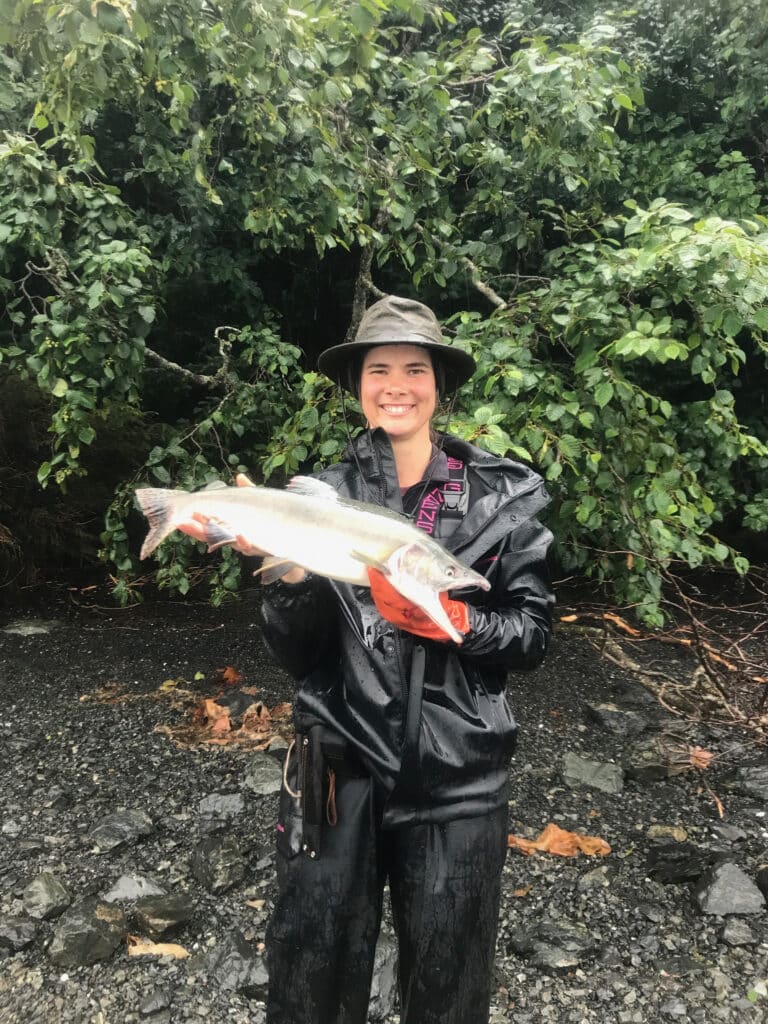
Above: Fishing in Alaska.
ROG: What do you do to maintain your survival skill set?
CF: Sometimes I use a bow drill to start my backyard fires. I’ll make baskets, tan hides, and teach classes. The skill set I practice daily is mindset, awareness, connection, and curiosity. Those in combination with a foundation of survival skills are what will help you survive any natural disaster or survival situation. They will also help you live with less stress and more joy on a daily basis!
ROG: What are some common mistakes you see when people are trying to learn and develop their survival skills?
CF: It is all too common for people to judge themselves when learning a new skill and give themselves a hard time for not getting it right away. I also see others — and I am guilty of it myself — thinking that you have to be way out there in the middle of nowhere to practice skills. Well, we don’t have to, often skills can be practiced in our backyards or a local green space. You can even use materials from a local hardware store if you don’t have the natural resources available. Another great technique is to build things, miniaturized. For example, if you can’t build a full-blown shelter to sleep in due to space limitations or available resources, just build a smaller version. You may not be able to sleep in it, but you’ll understand the mechanics of it better when it comes time to make the real thing.
ROG: Is there any skill you want to learn that you have not gotten around to yet?
CF: Working with animal hide. I’ve tanned a few hides over the years, but I’ve never taken that skill to the next level and made something out of it. Naturally tanned hides work a little differently than hides that have been commercially tanned. You have to be more careful when you cut and sew, otherwise the fibers in the leather will tear. My goal is to eventually make a shirt and a hoodie out of animal hides I have tanned.
ROG: You have a book in development. Is there anything you can share regarding what it is about, and when we can expect to see it come up for sale?
CF: My book is a memoir on my time living 86 days in Patagonia. It is written from a day-to-day perspective, and the reader follows along with the struggles and joys I experienced. Interwoven are stories from other parts of my life that I reflected on while I was there, and the bits of wisdom that I learned along the way. Depending on the editing and publishing process, you can expect it to be up for sale in 2023 or early 2024. The best way to learn about the progress of the publication is to sign up for the newsletter on my website carleighfairchild.com and you’ll be one of the first to know about it.
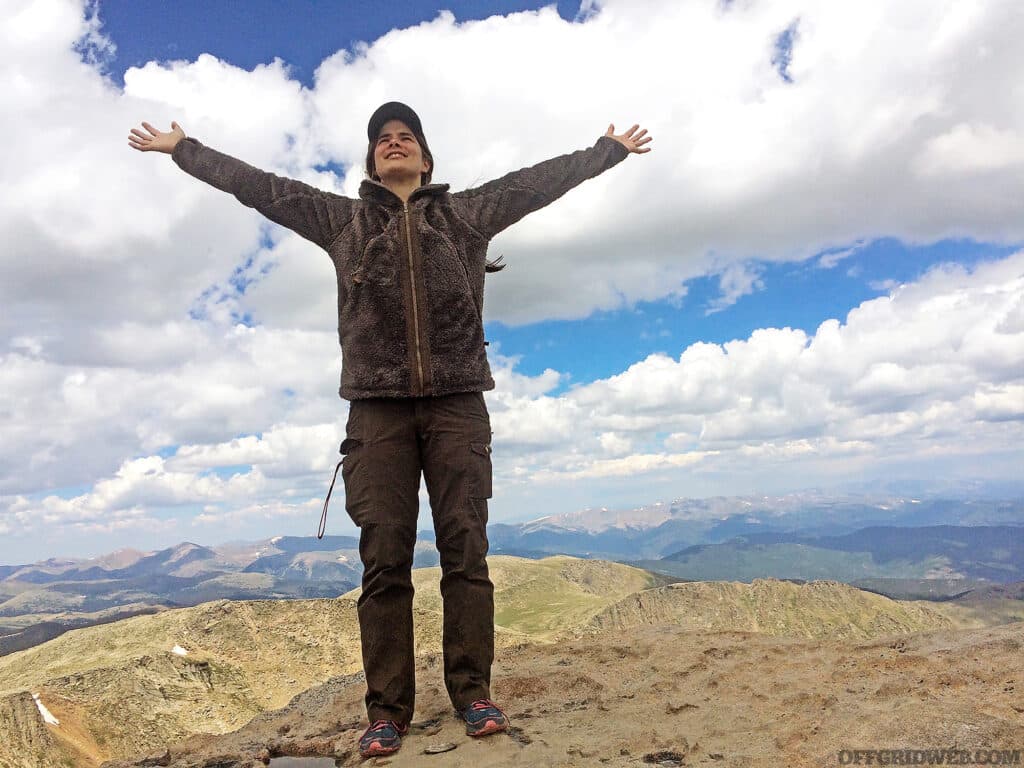
Hometown
I grew up in Columbus, Ohio. I currently live in Asheville, North Carolina.
Education
Childhood Idols
Survival Training/Experience
Recommended Reading List
Favorite Drinks
Favorite Quote
“Twenty years from now you will be more disappointed by the things you didn’t do than by the ones you did do. So throw off the bowlines. Sail away from the safe harbor. Catch the trade winds in your sails. Explore. Dream. Discover.” – Mark Twain
URL/Social Media:
EDC Gear
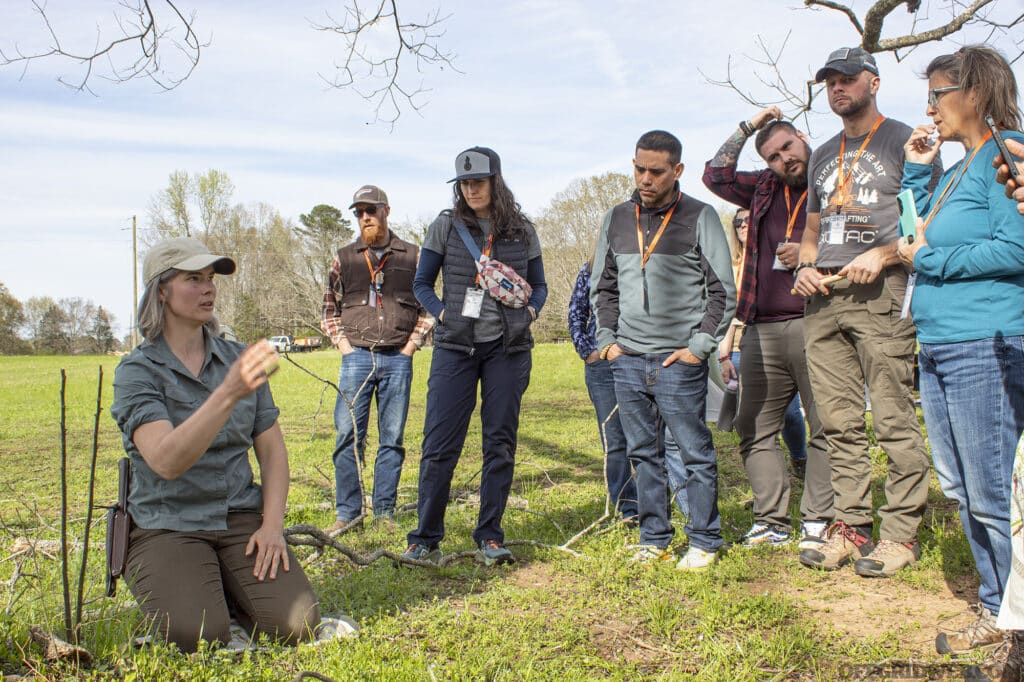
Above: Teaching students about wild edibles.
From the safety of our living rooms, it’s easy to watch a show like Alone and critique contestants from our sofas. What we see are the characters the show wants us to see for the sake of entertainment. But what we miss are the years of training and preparation, the hundreds of hours in between 10-second clips, and the true inner turmoil each contestant is going through. Until we test ourselves in a similar way, we have no true understanding of what it’s like to survive on our own in austerity for weeks at a time. So, when someone like Carleigh Fairchild decides to teach us something, or share that experience, we would all benefit by paying close attention.
Don't forget to subscribe to Recoil Offgrid's free newsletter for more content like this.
 STAY SAFE: Download a Free copy of the OFFGRID Outbreak Issue
STAY SAFE: Download a Free copy of the OFFGRID Outbreak Issue
No Comments